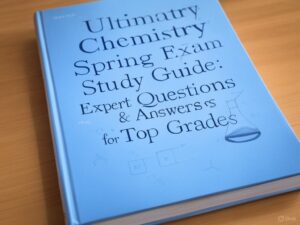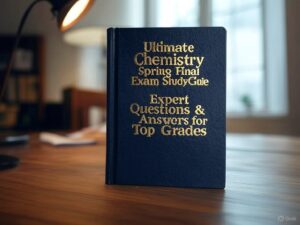Achieve top grades with the Ultimate Chemistry Spring Final Exam Study Guide, featuring expert questions and answers tailored for your success. This guide is designed for students preparing for their spring chemistry finals, covering essential topics like chemical equilibrium, acids and bases, electrochemistry, and molecular structure. Each question is expertly crafted to match the exam format, with detailed answers providing clear explanations to deepen your understanding of key concepts. Perfect for last-minute revisions or comprehensive study, this guide ensures you’re ready to excel in your spring final exam.
Preview
1. Which of the following represents an increase in entropy?
a) Freezing of water
b) Boiling of water
c) Crystallization of salt from a supersaturated solution
d) The reaction 2 NO(g) → N2O2(g)
e) The reaction 2 H2(g) + O2(g) → 2 H2O(g)
Correct Answer: b) Boiling of water
Rationale: Entropy (S) is a measure of disorder. When water boils, it changes from liquid to
gas, increasing molecular motion and disorder, which increases entropy.
2. The enthalpy of vaporization of methanol (CH₃OH) is 35.3 kJ/mol at the boiling point
of 64.2°C. Calculate the entropy change for methanol going from a liquid to vapor.
a) 600 J/K·mol
b) 551 J/K·mol
c) 105 J/K·mol
d) -105 J/K·mol
e) -551 J/K·mol
Correct Answer: c) 105 J/K·mol
Rationale: Entropy change is calculated using ΔS = ΔH / T (in Kelvin). Converting 64.2°C to
Kelvin: 64.2 + 273.15 = 337.35 K.
ΔS = (35.3 kJ/mol) / (337.35 K) = 105 J/K·mol.
3. Calculate the standard entropy change for the reaction:
Cu(s) + ½ O₂(g) → CuO(s)
Given:
• S°[Cu(s)] = 33.15 J/K·mol
• S°[O₂(g)] = 205.14 J/K·mol
• S°[CuO(s)] = 42.63 J/K·mol
a) 195.66 J/K
b) 93.09 J/K
c) -45.28 J/K
d) -93.09 J/K
e) 195.66 J/K
Correct Answer: d) -93.09 J/K
Rationale:
ΔS° = Σ S°(products) – Σ S°(reactants)
ΔS° = [42.63] – [33.15 + 0.5(205.14)]
ΔS° = 42.63 – 135.72 = -93.09 J/K.
4. In which of the following reactions do you expect a decrease in entropy?
a) Fe(s) → Fe(l)
b) Fe(s) + S(s) → FeS(s)
c) 2 Fe(s) + 3/2 O₂(g) → Fe₂O₃(s)
d) HF(l) → HF(g)
e) 2 H₂O₂(l) → 2 H₂O(l) + O₂(g)
Correct Answer: c) 2 Fe(s) + 3/2 O₂(g) → Fe₂O₃(s)
Rationale: The reaction results in the formation of a solid from a gas, which significantly
reduces disorder, leading to a decrease in entropy.
a) Freezing of water
b) Boiling of water
c) Crystallization of salt from a supersaturated solution
d) The reaction 2 NO(g) → N2O2(g)
e) The reaction 2 H2(g) + O2(g) → 2 H2O(g)
Correct Answer: b) Boiling of water
Rationale: Entropy (S) is a measure of disorder. When water boils, it changes from liquid to
gas, increasing molecular motion and disorder, which increases entropy.
2. The enthalpy of vaporization of methanol (CH₃OH) is 35.3 kJ/mol at the boiling point
of 64.2°C. Calculate the entropy change for methanol going from a liquid to vapor.
a) 600 J/K·mol
b) 551 J/K·mol
c) 105 J/K·mol
d) -105 J/K·mol
e) -551 J/K·mol
Correct Answer: c) 105 J/K·mol
Rationale: Entropy change is calculated using ΔS = ΔH / T (in Kelvin). Converting 64.2°C to
Kelvin: 64.2 + 273.15 = 337.35 K.
ΔS = (35.3 kJ/mol) / (337.35 K) = 105 J/K·mol.
3. Calculate the standard entropy change for the reaction:
Cu(s) + ½ O₂(g) → CuO(s)
Given:
• S°[Cu(s)] = 33.15 J/K·mol
• S°[O₂(g)] = 205.14 J/K·mol
• S°[CuO(s)] = 42.63 J/K·mol
a) 195.66 J/K
b) 93.09 J/K
c) -45.28 J/K
d) -93.09 J/K
e) 195.66 J/K
Correct Answer: d) -93.09 J/K
Rationale:
ΔS° = Σ S°(products) – Σ S°(reactants)
ΔS° = [42.63] – [33.15 + 0.5(205.14)]
ΔS° = 42.63 – 135.72 = -93.09 J/K.
4. In which of the following reactions do you expect a decrease in entropy?
a) Fe(s) → Fe(l)
b) Fe(s) + S(s) → FeS(s)
c) 2 Fe(s) + 3/2 O₂(g) → Fe₂O₃(s)
d) HF(l) → HF(g)
e) 2 H₂O₂(l) → 2 H₂O(l) + O₂(g)
Correct Answer: c) 2 Fe(s) + 3/2 O₂(g) → Fe₂O₃(s)
Rationale: The reaction results in the formation of a solid from a gas, which significantly
reduces disorder, leading to a decrease in entropy.












Reviews
There are no reviews yet.